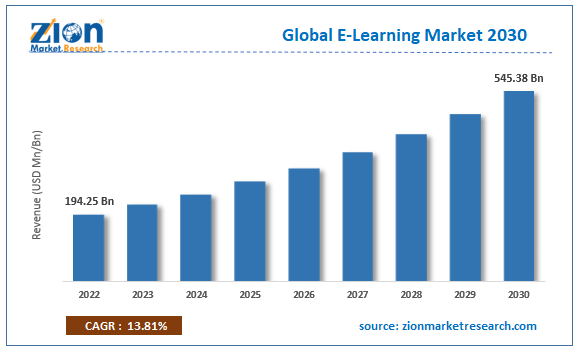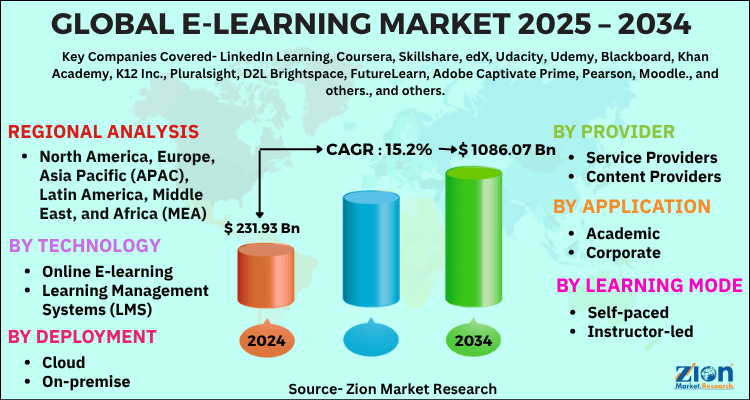E-Learning Market Size, Share, Trends, Growth and Forecast 2034

E-Learning Market By Technology (Online E-learning, Learning Management Systems (LMS), Mobile E-learning, Virtual Classrooms, Podcasts, Webinars), By Provider (Service Providers, Content Providers), By Application (Academic, Corporate, Government), By Learning Mode (Self-paced, Instructor-led), By Deployment (Cloud, On-premise), and By Region: Global and Regional Industry Overview, Market Intelligence, Comprehensive Analysis, Historical Data, and Forecasts 2025 - 2034
| Market Size in 2024 | Market Forecast in 2034 | CAGR (in %) | Base Year |
|---|---|---|---|
| USD 231.93 Billion | USD 1086.07 Billion | 15.2% | 2024 |
E-Learning Market: Industry Perspective
The global e-learning market size was worth around USD 231.93 Billion in 2024 and is predicted to grow to around USD 1086.07 Billion by 2034 with a compound annual growth rate (CAGR) of roughly 15.2% between 2025 and 2034. The report analyzes the global e-learning market's drivers, restraints/challenges, and the effect they have on the demands during the projection period. In addition, the report explores emerging opportunities in the e-learning industry.
E-Learning Market: Overview
E-learning, also known as electronic learning, is the system of delivering education, training, or learning using electronic or digital mediums. In the simplest form, e-learning is the digitization of the education sector and although the final curriculum is derived from formalized learning, the mode of delivery requires the use of tools such as laptops, smartphones, computers, and other devices connected through the internet.
E-learning offers a convenient way to learn new subjects and topics without visiting physical educational centers. It also allows students to learn from anywhere at any time without any restrictions. The ongoing expansion of the internet has played a crucial role in shaping the modern e-learning industry which is currently evolving at a steady pace with the introduction of new teaching methodologies and the adoption of advanced systems to deliver an immersive learning experience.
E-learning is not only beneficial to the students but also offers several advantages to the teachers or trainers conducting the lessons. However, it also comes with certain limitations that could act as barriers against growth during the forecast period.
Key Insights
- As per the analysis shared by our research analyst, the global e-learning market is estimated to grow annually at a CAGR of around 15.2% over the forecast period (2025-2034).
- Regarding revenue, the global e-learning market size was valued at around USD 231.93 Billion in 2024 and is projected to reach USD 1086.07 Billion by 2034.
- The e-learning market is projected to grow at a significant rate due to increasing internet access, remote education demand, flexible learning models, and investments in digital content, platforms, and personalized education tools.
- Based on Technology, the Online E-learning segment is expected to lead the global market.
- On the basis of Provider, the Service Providers segment is growing at a high rate and will continue to dominate the global market.
- Based on the Application, the Academic segment is projected to swipe the largest market share.
- By Learning Mode, the Self-paced segment is expected to dominate the global market.
- In terms of Deployment, the Cloud segment is anticipated to command the largest market share.
- Based on region, North America is predicted to dominate the global market during the forecast period.
E-Learning Market: Growth Drivers
Increasing investments in employee training by employers to drive market growth
The global e-learning market is expected to benefit from the growing investments in the training and development of employees. These projects are undertaken by employers for the benefit of the people working for the company which in turn translates to business efficiency in the long run.
The mode of conducting business is changing rapidly as it is influenced by the changes in the world of technology. Additionally, the introduction and adoption of novel and advanced systems in business operations is the only way companies can survive in the long run. However, the efficiency of employees in adapting to the changing technological trends is the most important factor in ensuring that a business leverages all the advantages offered by new tools and systems.
As companies have started understanding the benefits of investing in employees' technological and behavioral growth, the demand for corporate training and learning has increased. The ideal way for employees to undertake new training programs is with the aid of e-learning since it allows them to learn new subjects in the comfort of their homes. A recent report by Training magazine showed that companies in the United States had crossed the USD 100 billion mark in terms of employee training. These factors are likely to aid higher demand for corporate e-learning
Employees spending on professional growth may trigger higher revenue
In certain instances, corporate and business owners are voluntarily investing in their personal and professional growth to either improve their chances at a better job or help their own businesses flourish further. With increasing job opportunities along with high demand for technical experts, especially in niche markets, more people are willing to spend from personal expenses for a better chance at a high-paying job.
E-Learning Market: Restraints
Managing the quality of education in online classes is a major limitation against growth
One of the major drawbacks of the e-learning industry products and services is managing the quality of education during online classes. In physical classrooms, students are surrounded by other learners and this helps in fostering an environment for knowledge acquisition. However, with online classes, teachers do not have any control over ensuring that the students pay attention during the class. Moreover, there is a significant lack of efficient ways to curb cheating during e-learning which again diminishes the quality of knowledge-sharing programs.
E-Learning Market: Opportunities
Growing adoption of advanced teaching tools to create opportunities for higher growth
The growing demand for e-learning has prompted institutes to deploy more advanced learning tools that can assist in enhancing the learning experience. This includes the use of interactive whiteboards, virtual reality (VR) & augmented reality (AR) systems, extensive and comprehensive learning management systems (LMS), artificial intelligence (AI) powered tools, and many more. For instance, in July 2023, College Vidya, India’s first online education platform for distance learning announced the launch of an AI-powered product. This tool is designed to change the way students select online universities for further studies. On the other hand, edX, a leading player in the global market, launched an online edX expert and a new edX plugin for ChatGPT. The former is an AI-powered learning assistant
Growing partnerships between industry players to tap into new markets may promote further expansion
Global e-learning market players are forging strategic partnerships to make entry into new markets with huge potential for growth. A prime example is the partnership between Edmingle and McGraw Hill in August 2023. The former is an all-integrated software platform while the latter is a leading international education company. The companies have joined forces to shape digital innovation in India by providing students access to resources they can use to prepare for national competitive exams.
E-Learning Market: Challenges
Lack of infrastructure and high cost of e-learning to challenge market growth
Accessing e-learning platforms requires a stable internet connection and digital devices such as laptops or smartphones. However, countries with a larger population of low-income groups and underdeveloped nations do not have access to modern systems. They lack basic access to electricity and the internet. Moreover, the use of e-learning platforms requires some level of comfort with technological systems. However, people who have never previously used digital technology may find it difficult to use. The high cost of e-learning programs adds to greater challenges in the e-learning industry.
E-Learning Market: Segmentation
The global e-learning market is segmented based on end-user, deployment, course, provider, and region.
Based on end-user, the global market segments are government, corporate, and academic. In 2022, the highest growth was observed in the academic segment driven by an increasing number of e-learning programs conducted for students across the globe. The pandemic forced teaching institutes to adopt e-learning programs in their academic curriculum. Additionally, the corporate sector is also a significant contributor to the end-user segment. As per official data, around 74.1% of employers have shown a willingness to undergo training and learn new skills.
Based on deployment, the e-learning industry is divided into cloud and on-premise.
Based on the course, the global market divisions are online certification & professional development, primary & secondary education, test preparation, and higher education. In 2022, the highest revenue-generating segment was primary & secondary education due to the growing adoption of digital systems in colleges and schools to impart teachings and make learning an exciting experience. A recent survey concluded that almost 70% of surveyed students preferred online classes over in-person classrooms.
Based on provider, the e-learning industry segments are the service provider and content provider.
E-Learning Market: Report Scope
| Report Attributes | Report Details |
|---|---|
| Report Name | E-Learning Market |
| Market Size in 2024 | USD 231.93 Billion |
| Market Forecast in 2034 | USD 1086.07 Billion |
| Growth Rate | CAGR of 15.2% |
| Number of Pages | PagesNO |
| Key Companies Covered | LinkedIn Learning, Coursera, Skillshare, edX, Udacity, Udemy, Blackboard, Khan Academy, K12 Inc., Pluralsight, D2L Brightspace, FutureLearn, Adobe Captivate Prime, Pearson, Moodle., and others., and others. |
| Segments Covered | By Technology, By Provider, By Application, By Learning Mode, By Deployment, and By Region |
| Regions Covered | North America, Europe, Asia Pacific (APAC), Latin America, The Middle East and Africa (MEA) |
| Base Year | 2024 |
| Historical Year | 2020 to 2024 |
| Forecast Year | 2025 to 2034 |
| Customization Scope | Avail customized purchase options to meet your exact research needs. Request For Customization |
E-Learning Market: Regional Analysis
Europe to witness the highest growth rate during the projected timeframe
The global e-learning market is expected to be dominated by Europe during the forecast period. The primary reason is the excellent preparedness of European countries to adopt online learning curricula in their existing education program.
The region’s boost of excellent infrastructure with the generation population having higher access to digital tools needed for e-learning programs. Furthermore, companies in Europe are supporters of ensuring that their employees get opportunities to upskill and continue learning throughout their employment. In May 2023, the European Union announced the launch of the European Learning Model which intends to help the general population develop a skill-set that meets labor market requirements.
Asia-Pacific is expected to emerge as a leading revenue generator with the entry of international market players and growth in the number of domestic e-learning tool creators. In September 2023, the Indian government announced the launch of a job posting and e-learning platform called Skill India Development (SID). It will include free courses from technology giants such as Google, Microsoft, and Cisco.
E-Learning Market: Competitive Analysis
The report provides a company market share analysis to give a broader overview of the key market players. In addition, the report also covers key strategic developments of the market, including acquisitions & mergers, new product launches, agreements, partnerships, collaborations & joint ventures, research & development, and regional expansion of major participants involved in the e-learning market on a global and regional basis.
The global e-learning market is led by players like:
- LinkedIn Learning
- Coursera
- Skillshare
- edX
- Udacity
- Udemy
- Blackboard
- Khan Academy
- K12 Inc.
- Pluralsight
- D2L Brightspace
- FutureLearn
- Adobe Captivate Prime
- Pearson
- Moodle.
The global e-learning market is segmented as follows:
By End-User
- Government
- Corporate
- Academic
By Deployment
- Cloud
- On-Premise
By Course
- Online Certification & Professional Development
- Primary & Secondary Education
- Test Preparation
- Higher Education
By Provider
- Service Provide
- Content Provider
By Region
- North America
- The U.S.
- Canada
- Europe
- France
- The UK
- Spain
- Germany
- Italy
- Rest of Europe
- Asia Pacific
- China
- Japan
- India
- South Korea
- Southeast Asia
- Rest of Asia Pacific
- Latin America
- Brazil
- Mexico
- Rest of Latin America
- Middle East & Africa
- GCC
- South Africa
- Rest of Middle East & Africa
Table Of Content
Methodology
FrequentlyAsked Questions
E-learning, also known as electronic learning, is the system of delivering education, training, or learning using electronic or digital mediums.
The global e-learning market is expected to grow due to increasing internet access, remote education demand, flexible learning models, and investments in digital content, platforms, and personalized education tools.
According to a study, the global e-learning market size was worth around USD 231.93 Billion in 2024 and is expected to reach USD 1086.07 Billion by 2034.
The global e-learning market is expected to grow at a CAGR of 15.2% during the forecast period.
North America is expected to dominate the e-learning market over the forecast period.
Leading players in the global e-learning market include LinkedIn Learning, Coursera, Skillshare, edX, Udacity, Udemy, Blackboard, Khan Academy, K12 Inc., Pluralsight, D2L Brightspace, FutureLearn, Adobe Captivate Prime, Pearson, Moodle., and others., among others.
The report explores crucial aspects of the e-learning market, including a detailed discussion of existing growth factors and restraints, while also examining future growth opportunities and challenges that impact the market.
HappyClients
Zion Market Research
Tel: +1 (302) 444-0166
USA/Canada Toll Free No.+1 (855) 465-4651
3rd Floor,
Mrunal Paradise, Opp Maharaja Hotel,
Pimple Gurav, Pune 411061,
Maharashtra, India
Phone No +91 7768 006 007, +91 7768 006 008
US OFFICE NO +1 (302) 444-0166
US/CAN TOLL FREE +1 (855) 465-4651
Email: sales@zionmarketresearch.com
We have secured system to process your transaction.
Our support available to help you 24 hours a day, five days a week.
Monday - Friday: 9AM - 6PM
Saturday - Sunday: Closed






